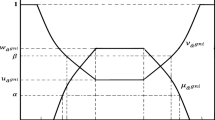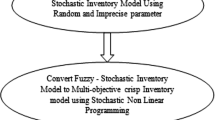Abstract
As a generalization of intuitionistic fuzzy set and Pythagorean fuzzy set, the q-Rung Orthopair Fuzzy Set (qROFS) and its application are implemented in some decision-making problems. So far the notion of qROFS is not yet applied in any inventory management problems. This chapter analyzed an inventory model under the q-rung orthopair fuzzy environment and utilized the knowledge measure of qROFS to the proposed model. This study explores an economic order quantity model with faulty products and screening errors. To satisfy the customers’ demand with perfect items, the proposed research utilized the product warranty claim strategy from the supplier. Since some of the faulty products are returned from the supplier without being replaced as good ones, this study examines under two cases say, the warranty unclaimed products are restored by mending option and the warranty unclaimed products are recovered by the emergency purchase option. For both cases, the q-Rung Orthopair Fuzzy (qROF) inventory model is framed by presuming the proportion of faulty products and the proportion of misclassification errors as q-Rung Orthopair Fuzzy Variables (qROFVs). The Knowledge Measure-based q-Rung Orthopair Fuzzy (KM-qROF) inventory model is proposed by computing the knowledge measure of qROFVs. The proposed model is illustrated with a numerical example along with the sensitivity analysis.
Access this chapter
Tax calculation will be finalised at checkout
Purchases are for personal use only
Similar content being viewed by others
References
M.I. Ali, Another view on q‐rung orthopair fuzzy sets. Int. J. Intell. Syst. 33, 2139–2153 (2018). https://doi.org/10. 1002/int.22007
K.T. Atanassov, Intuitionistic fuzzy sets. Fuzzy Sets Syst. 20, 87–96 (1986)
B. Farhadinia, H. Liao, Score-based multiple criteria decision making process by using p-rung orthopair fuzzy sets. INFORMATICA (2020). doi:https://doi.org/10.15388/20-INFOR412
H. Garg, A novel trigonometric operation-based q-rung orthopair fuzzy aggregation operator and its fundamental properties. Neural Comput. Appl. 32, 15077–15099 (2020). https://doi.org/10.1007/s00521-020-04859-x
H. Garg, S.M. Chen, Multiattribute group decision making based on neutrality aggregation operators of q- rung orthopair fuzzy sets. Inf Sci. 517, 427–447 (2020)
H. Garg, J. Gwak, T. Mahmood, Z. Ali, Power aggregation operators and vikor methods for complex q-rung orthopair fuzzy sets and their applications. Mathematics 8, 538 (2020)
H. Garg, A new possibility degree measure for interval-valued q-rung orthopair fuzzy sets in decision-making. Int J Intell Syst. 36, 526–557 (2021). https://doi.org/10.1002/int.22308
H. Garg, CN- qq-ROFS: Connection number-based q-rung orthopair fuzzy set and their application to decision-making process. Int. J. Intell. Syst. 36(7), 3106–3143 (2021). doi:https://doi.org/10.1002/int.22406
H. Garg, New exponential operation laws and operators for interval-valued q-rung orthopair fuzzy sets in group decision making process. Neural Comput. Appl. 33(20), 13937–13963 (2021). https://doi.org/10.1007/s00521-021-06036-0
J.T. Hsu, L.F. Hsu, An EOQ model with imperfect quality items, inspection errors, shortage backordering, and sales returns. Int. J. Prod. Econ. 143, 162–170 (2013)
M.Y. Jaber, S. Zanoni, L.E. Zanavella, Economic order quantity models for imperfect items with buy and repair options. Int. J. Prod. Econ. 155, 126–131 (2014)
M. Khan, M.Y. Jaber, M. Bonney, An economic order quantity (EOQ) for items with imperfect quality and inspection errors. Int. J. Prod. Econ. 133, 113–118 (2011)
M.J. Khan, M.I. Ali, M. Shutaywi, A new ranking technique for q-rung orthopair fuzzy values. Int. J. Intell. Syst. 36, 558–592 (2020). https://doi.org/10.1002/int.22311
M.J. Khan, P. Kumam, M. Shutaywi, Knowledge measure for the q-rung orthopair fuzzy sets. Int. J. Intell. Syst. 36(2), 628–655 (2020). https://doi.org/10.1002/int.22313
T.Y. Lin, M.T. Chen, An economic order quantity model with screening errors, returned cost, and shortages under quantity discounts. Afr. J. Bus. Manage. 5(4), 1129–1135 (2011)
P. Liu, S. Chen, P. Wang, Multiple-attribute group decision-making based on q-rung orthopair fuzzy power maclaurin symmetric mean operators. IEEE Trans. Syst. Man Cybern Syst. 50, 3741–3756 (2018). https://doi.org/10.1109/TSMC.2018.2852948
P. Liu, W. Liu, Multiple-attribute group decision-making method of linguistic q-rung orthopair fuzzy power Muirhead mean operators based on entropy weight. Int. J. Intell. Syst. 34, 1755–1794 (2019). https://doi.org/10.1002/int.22114
P. Liu, P. Wang, Some q-rung orthopair fuzzy aggregation operators and their applications to multiple- attribute decision making. Int. J. Intell. Syst. 33(2), 259–280 (2018)
P. Liu, Y. Wang, Multiple attribute decision making based on q-Rung Orthopair Fuzzy generalized Maclaurin symmetric mean operators. Inform. Sci. 518, 181–210 (2020)
J. Liu, H. Zheng, Fuzzy economic order quantity model with imperfect items, shortage and inspection errors. Syst. Eng. Proc. 4, 282–289 (2012)
S. Maity, S.K. De, S.P. Mondal, A study of a backorder EOQ model for cloud-type intuitionistic dense fuzzy demand rate. Int. J. Fuzzy Syst. 22, 201–211 (2019). https://doi.org/10.1007/s40815-019-00756-1
S. Papachristos, I. Konstantaras, Economic ordering quantity models for items with imperfect quality. Int. J. Prod. Econ. 100(1), 148–154 (2006)
R. Patro, M.M. Nayak, M. Acharya, An EOQ model for fuzzy defective rate with allowable proportionate discount. Opsearch 56, 191–215 (2019)
X. Peng, J. Dai, H. Garg, Exponential operation and aggregation operator for q-rung orthopair fuzzy set and their decision-making method with a new score function. Int. J. Intell. Syst. 33(11), 2255–2282 (2018). https://doi.org/10.1002/int.22028
P. Pimsap, W. Srisodaphol, Economic order quantity model for imperfect items under repair option and inspection errors. Brupa J Sci. 23(1), 92–104 (2018)
S. Rajeswari, C. Sugapriya, Fuzzy economic order quantity model with imperfect quality items under repair option. J. Res. Lepidoptera 51(1), 627–643 (2020)
S. Rajeswari, C. Sugapriya, D. Nagarajan, Fuzzy inventory model for NVOCC’s returnable containers under empty container repositioning with leasing option. Compl. Intell. Syst. 7, 753–764 (2021). https://doi.org/10.1007/s40747-020-00229-1
S. Rajeswari, C. Sugapriya, D. Nagarajan, An analysis of uncertain situation and advance payment system on a double-storage fuzzy inventory model. Opsearch (2021). https://doi.org/10.1007/s12597-021-00530-8
S. Rajeswari, C. Sugapriya, D. Nagarajan, J. Kavikumar, Optimization in fuzzy economic order quantity model involving pentagonal fuzzy parameter. Int. J. Fuzzy Syst. (2021). https://doi.org/10.1007/s40815-021-01111-z
M. Riaz, D. Pamucar, H.M.A. Farid, M.R. Hashmi, q-rung orthopair fuzzy prioritized aggregation operators and their application towards green supplier chain management. Symmetry 12, 976 (2020)
M. Riaz, H.M.A. Farid, H. Kalsoom, D. Pamucar, Y.-M. Chu, A robust q-rung orthopair fuzzy einstein prioritized aggregation operators with application towards MCGDM. Symmetry 12, 1058 (2020)
M. Riaz, H. Garg, H.M.A. Farid, M. Aslam, Novel Q-rung Orthopair fuzzy interaction aggregation operators and their application to low-carbon green supply Chain management. J. Intell. Fuzzy Syst. 41(2), 4109–4126 (2021). https://doi.org/10.3233/JIFS-210506
M.K. Salameh, M.Y. Jaber, Economic production quantity model for items with imperfect quality. Int. J. Prod. Econ. 64(1), 59–64 (2000)
B. Sarkar, S. Saren, Product inspection policy for an imperfect production system with inspection errors and warranty cost. European J. Operat. Res. 248, 263–271 (2016)
G. Wei, H. Gao, Y. Wei, Some q-rung orthopair fuzzy Heronian mean operators in multiple attribute decision making. Int. J. Intell. Syst. 33(7), 1426–1458 (2018). https://doi.org/10.1002/int.21985
Y. Xing, R. Zhang, J. Wang, K. Bai, J. Xue, A new multi-criteria group decision-making approach based on q- rung orthopair fuzzy interaction Hamy mean operators. Neural Comput. Appl. 32, 7465–7488 (2019). https://doi.org/10.1007/s00521-019-04269-8
R.R. Yager, Pythagorean fuzzy subsets. In Proceedings of Joint IFSA World Congress and NAFIPS, Annual Meeting, Edmonton, Canada, June 24–28, pp. 57–61 (2013). doi:https://doi.org/10.1109/IFSA‐NAFIPS.2013.6608375
R.R. Yager, A.M. Abbasov, Pythagorean membership grades, complex numbers, and decision making: pythagorean membership grades and fuzzy subsets. Int. J. Intell. Syst. 28, 436–452 (2013)
R.R. Yager, Generalized orthopair fuzzy sets. IEEE Trans. Fuzzy Syst. 25(5), 1222–1230 (2017)
R.R. Yager, N. Alajlan, Approximate reasoning with generalized orthopair fuzzy sets. Inf. Fusion. 38, 65–73 (2017). https://doi.org/10.1016/j.inffus.2017.02.005
Z. Yang, H. Garg, Interaction power partitioned Maclaurin symmetric mean operators under q-Rung orthopair uncertain linguistic information. Int. J. Fuzzy Syst. (2021). https://doi.org/10.1007/s40815-021-01062-5
Z. Yang, H. Garg, J. Li, Investigation of multiple heterogeneous relationships using a q-rung orthopair fuzzy multi-criteria decision algorithm. Neural Comput. Appl. 33(17), 10771–10786 (2021). https://doi.org/10.1007/s00521-020-05003-5
Z. Yang, X. Li, Z. Cao, J. Li, Q-rung orthopair normal fuzzy aggregation operators and their application in multi-attribute decision-making. Mathematics 7(12), 1142 (2019). https://doi.org/10.3390/math7121142
W.M. Yeo, X.M. Yuan, Optimal warranty policies for systems with imperfect repair. European J. Operat. Res. 199, 187–197 (2009)
L. Zadeh, Fuzzy sets. Inform. Control 8, 338–353 (1965)
Y. Zhongs, H. Gao, X. Guo, Y. Qin, M. Huang, X. Luo, Dombi power partitioned Heronian mean operators of q- rung orthopair fuzzy numbers for multiple attribute group decision making. PLoS ONE 14(10), e0222007 (2019). https://doi.org/10.1371/journal.pone.0222007
Y. Zhou, C. Chen, C. Li, Y. Zhong, A synergic economic order quantity model with trade credit, shortages, imperfect quality and inspection errors. Appl. Math. Model. 40, 1012–1028 (2016)
Author information
Authors and Affiliations
Corresponding author
Editor information
Editors and Affiliations
Appendix
Appendix
Computation of storage charge.
The holding charge is obtained by adding the five parts (a), (b), (c), (d), and (e) in Fig. 6.6.
Using the substitutions, \({\mathsf{I}}_{1} = {\mathsf{I}} - d\mathsf{t}_{1}\), \({\mathsf{I}}_{2} = {\mathsf{I}}_{1} - {\mathscr{Q}}_{1}\), \({\mathsf{I}}_{3} = {\mathsf{I}} - d\left( {\mathsf{t}_{1} + \mathsf{t}_{2} } \right) - {\mathscr{Q}}_{1}\),
\({\mathscr{Q}}^{\prime } = {\mathsf{I}}_{3} + \left( {{\mathscr{Q}}_{1} + {\mathscr{Q}}_{2} - \lambda \sigma {\mathsf{I}}} \right)\); where \(\mathsf{t}_{1} = \frac{{\mathsf{I}}}{\beta }\), \(\mathsf{t}_{2} = \frac{{{\mathscr{Q}}_{1} + {\mathscr{Q}}_{2} }}{{\mathscr{W}}} + \mathsf{t}_{{\text{w}}}\), \(\mathsf{t}_{3} = \frac{{{\mathscr{Q}}^{\prime } }}{d}\), \(\mathsf{t}_{4} = \frac{{\lambda \sigma {\mathsf{I}}}}{d}\) \({\mathscr{Q}}_{1} = \varepsilon_{2} {\mathsf{I}}\) and \({\mathscr{Q}}_{2} = \varepsilon_{3} {\mathsf{I}}\)
-
\(\left({\text{a}}\right)=\frac{\mathsf{h}}{2}{\mathsf{I}}^{2}\left({\frac{2}{\beta}-\frac{\mathsf{d}}{{\beta^{2}}}}\right)\)
-
\(\left( {\text{b}} \right) = \frac{\mathsf{h}}{2}{\mathsf{I}}^{2} \left( {\frac{{\left( {1 - \varepsilon_{2} - \frac{\mathsf{d}}{\beta }} \right)^{2} }}{\mathsf{d}}} \right)\)
-
\(\begin{aligned} \left( {\text{c}} \right) & = \frac{{\mathsf{h}_{W} }}{2}\left( {\frac{{{\mathscr{Q}}^{\prime } \,^{2} - {\mathsf{I}}_{3}^{2} }}{\mathsf{d}}} \right) \\ & = \mathsf{h}_{W} {\mathsf{I}}^{2} \left( {\varepsilon_{2} + \varepsilon_{3} - \lambda \sigma } \right)\left[ {\frac{1}{\mathsf{d}} - \frac{1}{\beta } - \frac{{\left( {\varepsilon_{2} + \varepsilon_{3} - \lambda \sigma } \right)}}{{\mathscr{W}}} - \frac{{\left( {\varepsilon_{2} - \varepsilon_{3} + \lambda \sigma } \right)}}{{2\mathsf{d}}}} \right] \\ & \quad \quad \quad \quad - \mathsf{h}_{W} {\mathsf{I}}\left( {\varepsilon_{2} + \varepsilon_{3} - \lambda \sigma } \right)\mathsf{t}_{{\text{w}}} { } \\ \end{aligned}\)
-
\(\left({\text{d}}\right)=\frac{{\mathsf{h}{\mathscr{Q}}_{2}{\mathscr{T}}^{\prime}}}{2}=\frac{{\mathsf{h}{\mathsf{I}}^{2}\varepsilon_{3}}}{{2\mathsf{d}}}\)
-
\(\left( {\text{e}} \right) = \frac{{\mathsf{h}_{R} \lambda \sigma {\mathsf{I}}\mathsf{t}_{4} }}{2} = \frac{{\mathsf{h}_{R} \left( {\lambda \sigma } \right)^{2} {\mathsf{I}}^{2} }}{{2\mathsf{d}}}\;\;[{\text{For}}\;{\text{case}}({\text{i}})]\)
-
\(\left( {\text{e}} \right) = \frac{{\mathsf{h}_{E} \lambda \sigma {\mathsf{I}}\mathsf{t}_{4} }}{2} = \frac{{\mathsf{h}_{E} \left( {\lambda \sigma } \right)^{2} {\mathsf{I}}^{2} }}{{2\mathsf{d}}}\;\;[{\text{For}}\;{\text{case}}\;({\text{ii}})]\)
On adding (a), (b), (c), (d), and (e), the holding charge for case (i) and case (ii) are given as follows:
and
Rights and permissions
Copyright information
© 2022 The Author(s), under exclusive license to Springer Nature Singapore Pte Ltd.
About this chapter
Cite this chapter
Sugapriya, C., Rajeswari, S., Nagarajan, D., Jeganathan, K. (2022). Knowledge Measure-Based q-Rung Orthopair Fuzzy Inventory Model. In: Garg, H. (eds) q-Rung Orthopair Fuzzy Sets. Springer, Singapore. https://doi.org/10.1007/978-981-19-1449-2_6
Download citation
DOI: https://doi.org/10.1007/978-981-19-1449-2_6
Published:
Publisher Name: Springer, Singapore
Print ISBN: 978-981-19-1448-5
Online ISBN: 978-981-19-1449-2
eBook Packages: Mathematics and StatisticsMathematics and Statistics (R0)





